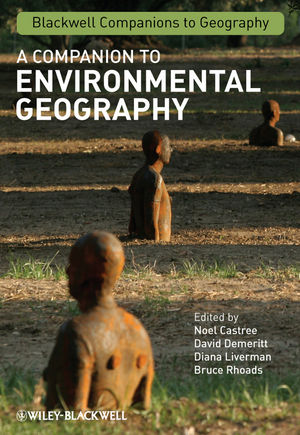A Companion to Environmental Geography: Brief Review
 A couple of weeks ago I received my copy of 'A Companion to Environmental Geography' to review for Progress in Physical Geography. I'm still working my way through the edited volume's diverse material, and on the review, but I thought I'd post a brief outline here along with a few thoughts.
A couple of weeks ago I received my copy of 'A Companion to Environmental Geography' to review for Progress in Physical Geography. I'm still working my way through the edited volume's diverse material, and on the review, but I thought I'd post a brief outline here along with a few thoughts. The diversity of issues and approaches demonstrated in the Companion is a result of both the editors' objectives to demonstrate the size, breadth and multiplicity of geographical work at the people-environment interface, and definition of environmental geography; "any form of geographical inquiry which considers formally some element of society or nature relative to each other" (p.6). The chapters address issues ranging from 'Complexity, Chaos and Emergence' and 'Uncertainty and Risk', through 'Landscape, Culture and Regional Studies' and 'Ecosystem Prediction and Management' to 'Marxist Political Economy and Environment' and 'Environmental Discourse and Representation'.
The editors' broad definition of Environmental Geography is, in part, a response to the increasing specialisation of science in general and geography specifically. Their definition is also a result of the perceived need to think more clearly about the relationships between the sub-discplines of geography rather than just the simple human/physical dichotomy, as I have discussed previously. Increasing research specialisation has resulted in a growing irrelevance of (and difficulty of achieving) the traditional view of 'symmetric' Environmental Geography in which both humans and their environment receive equal attention and treatment. Research in contemporary Environmental Geography is largely asymmetrical (i.e., research focus is generally more on either the human or environmental dimension) as demonstrated by the many of the chapters in the Companion.
Such a broad definition also allows the emphasis of what is seen as a traditional strength of Geography - the possibility of multiple diverse approaches to examine human-environment interactions. Indeed, editors Castree, Demeritt, Liverman and Rhoads suggest that "Environmental Geography's plurality can make it a player in such grand endeavours [as addressing global environmental chage and sustainability] yet without sacrificing its capability to offer multiple insights and perspectives on human-environment relations" (p.12). A player it may be, but other human-environment researchers are now arguing that their more systematic approaches move beyond Environmental Geography and, as Billie L. Turner's chapter highlights, the geography is no longer necessarily the primary domain of the study of coupled human-environment systems; "the immediate future appears to be one in which geographic practitioners of land systems are drawn increasingly into integrative science programmes, while geograghic pedagogy, more so than at any other time in the past, opens to practitioners from beyond the formal discipline" (p.174).
The Companion, is certainly more than a Dictionary - each of the 32 chapters following the introduction from the editors provides an introduction to key ideas, methods and debates that will be accessible to advanced undergraduates and beyond. The chapters are divided into four sections - Concepts, Approaches, Practices, and Topics - some tackling questions at the cutting edge (e.g., what are the interlinked social and environmental implications of commodifying nature, and of commodification more generally?), some calling for advances or changes in perspective (e.g., current consideration of uncertainty and risk is a facade on deterministic approaches) and others providing more benign, yet no less stimulating, introductions to the issues. Such is the diversity of human-environment issues covered that not all chapters will be of interest to all readers. However, the book will be a useful reference for all scholars of human-environment interactions, whether to provide inspiration for potential research approaches or as a teaching tool to introduce students to the breadth of topics in Environmental Geography.
I'll post again with a link to the final review once it's published.
Buy at Amazon
Labels: Academic, Book_Review, Geographic

This work by James D.A. Millington is licensed under a Creative Commons Attribution-Noncommercial-Share Alike 3.0 United States License.


0 Comments:
Post a Comment
<< Home